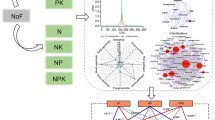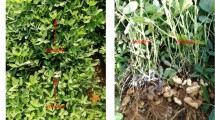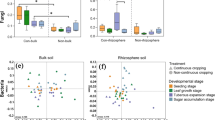Abstract
Purpose
Soil pH and microbial community composition are crucial determinates of plant health. However, their contributions to the success or failure of plant pathogen colonization and the underlying mechanisms are still unknown.
Methods
We used real-time PCR and Miseq sequencing to investigate the colonization efficiency of Ralstonia solanacearum, a typical plant pathogen, in diverse pH values (6.2, 7.0, and 7.8) and residential microbial communities created by soil sterilization and microbial re-inoculation.
Results
Both pH and microbial re-inoculation significantly influenced the composition of soil bacterial community, while the relative importance of pH (86.44%) far outweighed that of microbial re-inoculation (4.32%). The abundance of R. solanacearum was significantly lower and the complexity of soil microbial network was higher in soils with a higher pH value, and meanwhile the relative abundances of key pathogen-antagonistic microbes were significantly increased in these soils. Structural equation modeling and an independent verification test further suggested that the indirect effect of soil pH, or the effect of soil pH on bacterial community composition, was the primary driver of the success or failure of R. solanacearum colonization. The incidence of bacterial wilt disease was highly variable, but the disease incidence was lowest in low pH soils. Low disease incidence was mainly attributed to the significant increase of key microbes, such as Firmicutes, Paenibacillus, Luteibacter, Chitinophagaceae, and Rhodanobacter, which are known to induce systemic resistance in plant.
Conclusions
Our results suggest that soil pH indirectly determines plant pathogen colonization through its impact on soil microbial community composition.






Similar content being viewed by others
Data Availability
The raw sequencing data were deposited at the NCBI Sequence Read Archive database with the accession number of PRJNA824239.
References
Abdelkrim S, Jebara SH, Saadani O, Jebara M (2018) Potential of efficient and resistant plant growth-promoting rhizobacteria in lead uptake and plant defence stimulation in Lathyrus sativus under lead stress. Plant Biol 20:857–869. https://doi.org/10.1111/plb.12863
Baer CF (2019) Evolution: Environmental Dependence of the Mutational Process. Curr Biol 29:R415–R417. https://doi.org/10.1016/j.cub.2019.04.049
Bailey VL, Fansler SJ, Stegen JC, McCue LA (2013) Linking microbial community structure to β-glucosidic function in soil aggregates. ISME J 7:2044–2053. https://doi.org/10.1038/ismej.2013.87
Bastian M, Heymann S, Jacomy M (2009) Gephi: an open source software for exploring and manipulating networks. ICWSM 8:361–362
Caporaso JG, Kuczynski J, Stombaugh J, Bittinger K, Bushman FD, Costello EK, Fierer N, Peña AG, Goodrich JK, Gordon JI (2010) QIIME allows analysis of high-throughput community sequencing data. Nat Methods 7:335–336. https://doi.org/10.1038/nmeth.f.303
Chaloner TM, Gurr SJ, Bebber DP (2020) Geometry and evolution of the ecological niche in plant-associated microbes. Nat Commun 11:2955. https://doi.org/10.1038/s41467-020-16778-5
Dalsing BL, Allen C (2014) Nitrate assimilation contributes to Ralstonia solanacearum root attachment, stem colonization, and virulence. J Bacteriol 196:949–960. https://doi.org/10.1128/JB.01378-13
Dangl JL, Jones JDG (2001) Plant pathogens and integrated defence responses to infection. Nature 411:826–833. https://doi.org/10.1038/35081161
Das K, Rajawat MVS, Saxena AK, Prasanna R (2017) Development of Mesorhizobium ciceri-Based Biofilms and Analyses of Their Antifungal and Plant Growth Promoting Activity in Chickpea Challenged by Fusarium Wilt. Indian J Microbiol 57:48–59. https://doi.org/10.1007/s12088-016-0610-8
Delmont TO, Francioli D, Jacquesson S, Laoudi S, Mathieu A, Nesme J, Ceccherini MT, Nannipieri P, Simonet P, Vogel TM (2014) Microbial community development and unseen diversity recovery in inoculated sterile soil. Biol Fert Soils 50:1069–1076. https://doi.org/10.1007/s00374-014-0925-8
Deng XH, Zhang N, Li YC, Zhu CZ, Qu BY, Liu HJ, Li R, Bai Y, Shen QR, Salles JF (2022) Bio-organic soil amendment promotes the suppression of Ralstonia solanacearumby inducing changes in the functionality and composition of rhizosphere bacterial communities. New Phytol. https://doi.org/10.1111/nph.18221
Dombrowski N, Schlaeppi K, Agler MT, Hacquard S, Kemen E, Garrido-Oter R, Wunder J, Coupland G, Schulze-Lefert P (2017) Root microbiota dynamics of perennial Arabis alpina are dependent on soil residence time but independent of flowering time. ISME J 11:43–55
Fan KK, Weisenhorn P, Gilbert JA, Shi Y, Bai Y, Chu HY (2018) Soil pH correlates with the co-occurrence and assemblage process of diazotrophic communities in rhizosphere and bulk soils of wheat fields. Soil Biol Biochem 121:185–192. https://doi.org/10.1016/j.soilbio.2018.03.017
Fierer N (2017) Embracing the unknown: disentangling the complexities of the soil microbiome. Nat Rev Microbiol 15:579–590. https://doi.org/10.1038/nrmicro.2017.87
Fierer N, Jackson RB (2006) The diversity and biogeography of soil bacterial communities. PNAS 103:626–631. https://doi.org/10.1073/pnas.0507535103
Fondi M, Karkman A, Tamminen MV, Bosi E, Virta M, Fani R, Alm E, Mclnerney JO (2016) “every gene is everywhere but the environment selects”: global geolocalization of gene sharing in environmental samples through network analysis. Genome Biol Evol 8:1388–1400. https://doi.org/10.1093/gbe/evw077
Giné A, Carrasquilla M, Martinez-Alonso M, Gaju N, Sorribas FJ (2016) Characterization of Soil Suppressiveness to Root-Knot Nematodes in Organic Horticulture in Plastic Greenhouse. Front Plant Sci 7:164. https://doi.org/10.3389/fpls.2016.00164
Gupta R, Elkabetz D, Leibman-Markus M, Sayas T, Schneider A, Jami E, Kleiman M, Bar M (2022) Cytokinin drives assembly of the phyllosphere microbiome and promotes disease resistance through structural and chemical cues. ISME J 16:122–137. https://doi.org/10.1038/s41396-021-01060-3
Huang XQ, Liu LL, Zhao J, Zhang JB, Cai ZC (2018) The families Ruminococcaceae, Lachnospiraceae, and Clostridiaceae are the dominant bacterial groups during reductive soil disinfestation with incorporated plant residues. Appl Soil Ecol 135:65–72. https://doi.org/10.1016/j.apsoil.2018.11.011
Huang XQ, Zhou X, Zhang JB, Cai ZC (2019) Highly connected taxa located in the microbial network are prevalent in the rhizosphere soil of healthy plant. Biol Fert Soils 55:299–312. https://doi.org/10.1007/s00374-019-01350-1
Huo Y, Jong-Pyo KJP, Park JK, Li JF, Chen L, Yang DC (2018) Rhodanobacter ginsengiterrae sp. nov., an antagonistic bacterium against root rot fungal pathogen Fusarium solani, isolated from ginseng rhizospheric soil. Arch Microbiol 200:1457–1463. https://doi.org/10.1007/s00203-018-1560-9
IUSS Working Group WRB (2007) World reference base for soil resources 2006. First update 2007. World soil resources reports 103. FAO, Rome. http://www.fao.org/fileadmin/templates/nr/images/resources/pdf_documents/wrb2007_red.pdf. Accessed 15 June 2022
Janvier C, Villeneuve F, Alabouvette C, Edel-Hermann V, Mateille T, Steinberg C (2007) Soil health through soil disease suppression: which strategy from descriptors to indicators? Soil Biol Biochem 39:1–23. https://doi.org/10.1016/j.soilbio.2006.07.001
Jiang GF, Wang NQ, Zhang YY, Wang Z, Zhang YL, Yu JB, Zhang Y, Wei Z, Xu YC, Geisen S, Firman VP, Shen QR (2021) The relative importance of soil moisture in predicting bacterial wilt disease occurrence. Soil Ecol Lett 3:356–366. https://doi.org/10.1007/s42832-021-0086-2
Jiao S, Lu Y (2020) Soil pH and temperature regulate assembly processes of abundant and rare bacterial communities in agricultural ecosystems. Environ Microbiol 22:1052–1065. https://doi.org/10.1111/1462-2920.14815
Lacey MJ, Wilson CR (2010) Relationship of Common Scab Incidence of Potatoes Grown in Tasmanian Ferrosol Soils with pH, Exchangeable Cations and other Chemical Properties of those Soils. J Phytopathol 149:679–683. https://doi.org/10.1046/j.1439-0434.2001.00693.x
Lee B, Farag MA, Park HB, Kloepper JW, Lee SH, Ryu CM (2012) Induced Resistance by a Long-Chain Bacterial Volatile: Elicitation of Plant Systemic Defense by a C13 Volatile Produced by Paenibacillus polymyxa. PLoS ONE 7:e48744. https://doi.org/10.1371/journal.pone.0048744
Lee SM, Kong HG, Song GC, Ryu CM (2021) Disruption of Firmicutes and Actinobacteria abundance in tomato rhizosphere causes the incidence of bacterial wilt disease. ISME J 15:330–347. https://doi.org/10.1038/s41396-020-00785-x
Li M, Pommier T, Yin Y, Wang J, Gu SH, Jousset A, Keuskamp J, Wang H, Wei Z, Xu YC, Shen QR, Kowalchuk GA (2021) Indirect reduction of Ralstonia solanacearum via pathogen helper inhibition. ISME J 16:868–875. https://doi.org/10.1038/s41396-021-01126-2
Li S, Liu Y, Wang J, Liang Y, Zhang S, Xu C, Wei D (2017) Soil Acidification Aggravates the Occurrence of Bacterial Wilt in South China. Front Microbiol 8:703. https://doi.org/10.3389/fmicb.2017.00703
Liu LL, Huang XQ, Zhang JB, Cai ZC, Jiang K, Chang YY (2020) Deciphering the relative importance of soil and plant traits on the development of rhizosphere microbial communities. Soil Biol Biochem 148:107909. https://doi.org/10.1016/j.soilbio.2020.107909
Liu LL, Huang XQ, Zhao J, Zhang JB, Cai ZC (2019) Characterizing the Key Agents in a Disease-Suppressed Soil Managed by Reductive Soil Disinfestation. Appl Environ Microb. 85:e02992-e3018. https://doi.org/10.1016/10.1128/AEM.02992-18
Liu LL, Yan YY, Ding HX, Zhao J, Cai ZC, Dai CC, Huang XQ (2021) The fungal community outperforms the bacterial community in predicting plant health status. Appl Microbiol Biot 105:6499–6513. https://doi.org/10.1007/s00253-021-11486-6
Liu Y, Qiao J, Liu Y, Liang X, Zhou Y, Liu JB (2019b) Characterization of Lysobacter capsici strain NF87–2 and its biocontrol activities against phytopathogens. Eur J Plant Pathol 155:859–869. https://doi.org/10.1007/s10658-019-01817-9
Mazzola M, Freilich S (2017) Prospects for Biological Soilborne Disease Control: Application of Indigenous Versus Synthetic Microbiomes. Phytopathology 107:256–263. https://doi.org/10.1094/PHYTO-09-16-0330-RVW
McDonald D, Price MN, Goodrich J, Nawrocki EP, DeSantis TZ, Probst A, Andersen GL, Knight R, Huagenholtz P (2012) An improved Green genes taxonomy with explicit ranks for ecological and evolutionary analyses of bacteria and archaea. ISME J 6:610–618. https://doi.org/10.1038/ismej.2011.139
McMurdie PJ, Holmes S, Michael W (2013) Phyloseq: an R package for reproducible interactive analysis and graphics of microbiome census data. PLoS ONE 8:e61217. https://doi.org/10.1371/journal.pone.0061217
Mendes R, Kruijt M, de Bruijn I, Dekkers E, van der Voort M, Schneider JHM, Piceno YM, DeSantis TZ, Andersen GL, Bakker PAHM, Raaijmakers JM (2011) Deciphering the rhizosphere microbiome for disease-suppressive bacteria. Science 332:1097–1100. https://doi.org/10.1126/science.1203980
Meng TZ, Ren GD, Wang GF, Ma Y (2019) Impacts on soil microbial characteristics and their restorability with different soil disinfestation approaches in intensively cropped greenhouse soils. Appl Microbiol Biot 103:6369–6383. https://doi.org/10.1007/s00253-019-09964-z
Merkle EC, Rosseel Y (2018) blavaan: Bayesian structural equation models via parameter expansion. Stats 85:129-138. https://doi.org/10.18637/jss.v085.i04
Nannipieri P, Muccini L, Ciardi C (1983) Microbial biomass and enzyme activities: production and persistence. Soil Biol Biochem 15:679–685. https://doi.org/10.1016/0038-0717(83)90032-9
Oksanen J, Blanchet FG, Friednly M, Kindt R, Legendre P, McGlinn D, Minchin PR, O’Hara RB, Simpson GL, Solymos P, Stevens MHH, Szoecs E, Wagner H (2022) Vegan: Community Ecology Package. R Package Version 2.5–7. https://cran.r-project.org/web/packages/vegan/index.html. Published 28 February 2022
Pagaling E, Strathdee F, Spears BM, Cates ME, Allen RJ, Free A (2014) Community history affects the predictability of microbial ecosystem development. ISME J 8:19–30. https://doi.org/10.1038/ismej.2013.150
Park KY, Seo SY, Oh BR, Seo JW, Kim YJ (2018) 2,3-butanediol Induces Systemic Acquired Resistance in the Plant Immune Response. J Plant Biol 61:424–434. https://doi.org/10.1007/s12374-018-0421-z
Rillig MC, Ryo M, Lehmann A, Aguilar-Trigueros CA, Buchert S, Wulf A, Iwasaki A, Roy J, Yang G (2019) The role of multiple global change factors in driving soil functions and microbial biodiversity. Science 366:886–890. https://doi.org/10.1126/science.aay2832
Robinson MD, McCarthy DJ, Smyth GK (2010) edger: a Bioconductor package for differential expression analysis of digital gene expression data. Bioinformatics 26:139–140. https://doi.org/10.1093/bioinformatics/btp616
Romdhane S, Spor A, Aubert J, Bru D, Breuil MC, Hallin S, Mounier A, Ouadah S, Tsiknia M, Philippot L (2021) Unraveling negative biotic interactions determining soil microbial community assembly and functioning. ISME J 16:296–306. https://doi.org/10.1038/s41396-021-01076-9
Rybakova D, Cernava T, Köberl M, Liebminger S, Etemadi M, Berg G (2016) Endophytes-assisted biocontrol: novel insights in ecology and the mode of action of Paenibacillus. Plant Soil 405:125–140. https://doi.org/10.1007/s11104-015-2526-1
Senechkin IV, van Overbeek LS, van Bruggen AHC (2014) Greater Fusarium wilt suppression after complex than after simple organic amendments as affected by soil pH, total carbon and ammonia-oxidizing bacteria. Appl Soil Ecol 73:148–155. https://doi.org/10.1016/j.apsoil.2013.09.003
Shen G, Zhang S, Liu X, Jiang Q, Ding W (2018) Soil acidification amendments change the rhizosphere bacterial community of tobacco in a bacterial wilt affected field. Appl Microbiol Biot 102:9781–9791. https://doi.org/10.1007/s00253-018-9347-0
Shen ZZ, Ruan YZ, Chao X, Zhang J, Li R, Shen QR (2015) Rhizosphere microbial community manipulated by 2 years of consecutive biofertilizer application associated with banana Fusarium wilt disease suppression. Biol Fert Soils 51:553–562. https://doi.org/10.1007/s00374-015-1002-7
Shi Y, Li YT, Xiang XJ, Sun RB, Yang T, He D, Zhang KP, Ni YY, Zhu YG, Adams JM, Chu HY (2018) Spatial scale affects the relative role of stochasticity versus determinism in soil bacterial communities in wheat fields across the North China Plain. Microbiome 6:27. https://doi.org/10.1186/s40168-018-0409-4
Steinhauser D, Krall L, Mussig C, Bussis D, Usadel B (2007) Correlation networks. In: Junker BH, Schreiber F (eds) Analysis of biological networks. John Wiley & Sons Inc, New Jersey, pp 305–333
Tripathi BM, Stegen JC, Kim M, Dong K, Adams JM, Lee YK (2018) Soil pH mediates the balance between stochastic and deterministic assembly of bacteria. ISME J 12:1072–1083. https://doi.org/10.1038/s41396-018-0082-4
Velásquez A, Castroverde CDM, He SY (2018) Plant-Pathogen Warfare under Changing Climate Conditions. Curr Biol 28:R619–R634. https://doi.org/10.1016/j.cub.2018.03.054
Wang Y, Zhao Y, Kong F, Wang X, Chen D, Feng C, Wang W, Wang X, Wang J (2018) Effects of pH on growth characteristics of Ralstonia solanacearum in tobacco. Tobacco Science & Technology (China) 51:27–32. https://doi.org/10.16135/j.issn1002-0861.2018.0227
Wang BY, Xia Q, Li YL, Zhao J, Yang SZ, Wei FG, Huang XQ, Zhang JB, Cai ZC (2021) Root rot-infected Sanqi ginseng rhizosphere harbors dynamically pathogenic microbiotas driven by the shift of phenolic acids. Plant Soil 465:385–402. https://doi.org/10.1007/s11104-021-05034-4
Wang TT, Hao YW, Zhu MZ, Yu ST, Ran W, Xue C, Ling N, Shen QR (2019) Characterizing differences in microbial community composition and function between Fusarium wilt diseased and healthy soils under watermelon cultivation. Plant Soil 438:421–433. https://doi.org/10.1007/s11104-019-04037-6
Watanabe K, Matsui M, Honjo H, Becker JO, Fukui R (2011) Effects of soil pH on rhizoctonia damping-off of sugar beet and disease suppression induced by soil amendment with crop residues. Plant Soil 347:255–268. https://doi.org/10.1007/s11104-011-0843-6
Wei Z, Hu J, Gu YA, Yin SX, Xu YC, Jousset A, Shen QR, Friman VP (2017) Ralstonia solanacearum pathogen disrupts bacterial rhizosphere microbiome during an invasion. Soil Biol Biochem 118:8–17. https://doi.org/10.1016/j.soilbio.2017.11.012
Wei Z, Gu YA, Friman V, Kowalchuk G, Xu YC, Shen QR, Jousset A (2019) Initial soil microbiome composition and functioning predetermine future plant health. Sci Adv 5:eaaw0759. https://doi.org/10.1126/sciadv.aaw0759
Wicker E, Grassart L, Coranson-Beaudu R, Mian D, Guilbaud C, Fegan M, Prior P (2007) Ralstonia solanacearum strains from martinique (french west indies) exhibiting a new pathogenic potential. Appl Environ Microb 73:6790–6801. https://doi.org/10.1128/AEM.00841-07
Xun WB, Huang T, Zhao J, Ran W, Wang BR, Shen QR, Zhang RF (2015) Environmental conditions rather than microbial inoculum composition determine the bacterial composition, microbial biomass and enzymatic activity of reconstructed soil microbial communities. Soil Biol Biochem 90:10–18. https://doi.org/10.1016/j.soilbio.2015.07.018
Yang TJ, Wei Z, Friman VP, Xu YC, Shen QR, Kowalchuk GA, Jousset A (2017) Resource availability modulates biodiversity-invasion relationships by altering competitive interactions. Environ Microbiol 19:2984–2991. https://doi.org/10.1111/1462-2920.13708
Yu M, Zhao Y (2020) Cell permeability, β-lactamase activity, and transport contribute to high level of resistance to ampicillin in Lysobacter enzymogenes. Appl Microbiol Biot 104:1149–1161. https://doi.org/10.1007/s00253-019-10266-7
Zamioudis C, Hanson J, Pieterse CMJ (2015) β-Glucosidase BGLU42 is a MYB72-dependent key regulator of rhizobacteria-induced systemic resistance and modulates iron deficiency responses in Arabidopsis roots. New Phytol 204:368–379. https://doi.org/10.1111/nph.12980
Zhou X, Li CY, Liu LL, Zhao J, Zhang JB, Cai ZC, Huang XQ (2019) Control of Fusarium wilt of lisianthus by reassembling the microbial community in infested soil through reductive soil disinfestation. Microbiol Res 220:1–11. https://doi.org/10.1016/j.micres.2018.12.001
Acknowledgements
The authors thanks the editors and reviewers for their valuable comments and suggestions. We also acknowledge TopEdit LLC for the linguistic editing and proofreading during the preparation of this manuscript.
Funding
This work was financially supported by the National Natural Science Foundation of China (Grant No. U21A20226, 42090065 and 32160748), the Key-Area Research and Development Program of Guangdong Province (2020B0202010006), the China Postdoctoral Science Foundation (2021M691625), and the Key Research and Development Project (Agriculture) of Yichun City, Jiangxi Province (20211YFN4240).
Author information
Authors and Affiliations
Contributions
X.Q.H., C.C.D., and Z.C.C. conceived designed research. L.L.L., Z.Y.C., Z.S., and S.L. performed the experiment and collected the data. L.L.L and A.A. analysed the data. L.L.L. wrote the manuscript. All authors read and approved the manuscript.
Corresponding author
Ethics declarations
Competing Interest
The authors declare that they have no conflicts of interest.
Additional information
Responsible Editor: Birgit Mitter.
Publisher's note
Springer Nature remains neutral with regard to jurisdictional claims in published maps and institutional affiliations.
Supplementary Information
Below is the link to the electronic supplementary material.
Rights and permissions
Springer Nature or its licensor holds exclusive rights to this article under a publishing agreement with the author(s) or other rightsholder(s); author self-archiving of the accepted manuscript version of this article is solely governed by the terms of such publishing agreement and applicable law.
About this article
Cite this article
Liu, L., Chen, Z., Su, Z. et al. Soil pH indirectly determines Ralstonia solanacearum colonization through its impacts on microbial networks and specific microbial groups. Plant Soil 482, 73–88 (2023). https://doi.org/10.1007/s11104-022-05671-3
Received:
Accepted:
Published:
Issue Date:
DOI: https://doi.org/10.1007/s11104-022-05671-3




